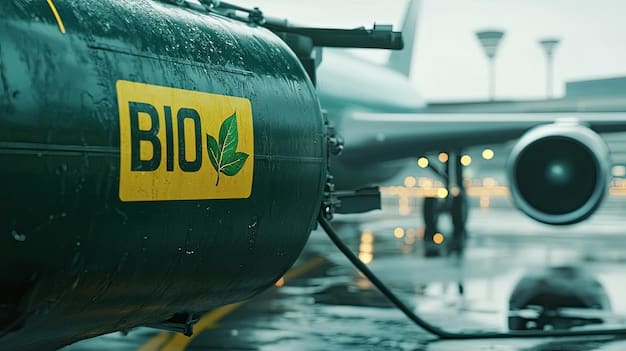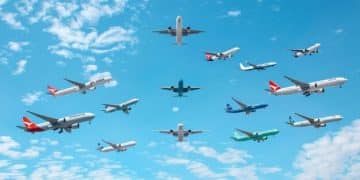Aviation Fuel Prices Surge: Strategies Airlines Are Using

Aviation fuel prices are surging, impacting airlines globally, and they are responding with strategies such as fuel hedging, fleet modernization, surcharges, and operational efficiencies to mitigate the increased costs.
The **aviation fuel prices surge** is significantly impacting airline operations worldwide, forcing them to adapt and innovate to manage rising costs. Airlines are implementing various strategies to navigate these challenges and maintain profitability.
Aviation Fuel Price Volatility: An Overview
Aviation fuel, also known as jet fuel, is a significant expense for airlines. The volatility in its pricing can greatly affect profitability and operational planning. Recent geopolitical events and economic factors have contributed to sharp increases in aviation fuel prices, prompting airlines to take action.
Factors Influencing Aviation Fuel Prices
Several factors contribute to the fluctuations in aviation fuel prices. These include:
- Crude Oil Prices: Aviation fuel is refined from crude oil, so its price is directly linked to crude oil market prices.
- Geopolitical Tensions: Political instability and conflicts in oil-producing regions can disrupt supply and increase prices.
- Refining Capacity: Limited refining capacity can lead to supply bottlenecks and higher prices, even if crude oil is abundant.
- Seasonal Demand: Increased travel during peak seasons raises demand for jet fuel, which can drive up prices.
The Impact on Airline Operations
Rising aviation fuel prices affect nearly all aspects of airline operations. This includes:
- Increased Operational Costs: Fuel costs represent a significant portion of an airline’s operating expenses, and increases directly affect profitability.
- Ticket Prices: Airlines may pass on some of the increased costs to passengers through higher ticket prices.
- Route Adjustments: Some less profitable routes may be cut or altered to conserve fuel.
- Fleet Management: Airlines might accelerate the retirement of older, less fuel-efficient aircraft.
In conclusion, aviation fuel price volatility presents ongoing challenges for the airline industry. Understanding the factors behind these fluctuations is crucial for effective management and adaptation.
Fuel Hedging Strategies: Reducing Uncertainty
To mitigate the impact of fluctuating fuel prices, many airlines employ fuel hedging strategies. Fuel hedging is essentially a risk management technique that allows airlines to lock in future fuel prices, providing a degree of certainty in their operational costs.
How Fuel Hedging Works
Fuel hedging typically involves using financial instruments such as:
- Futures Contracts: Agreements to buy or sell a specific amount of fuel at a predetermined price and date.
- Options Contracts: The right, but not the obligation, to buy or sell fuel at a specific price before a certain date.
- Swaps: Agreements to exchange a floating price for a fixed price, effectively stabilizing fuel costs.
By using these instruments, airlines can protect themselves from sudden price spikes. However, hedging also carries risks, as airlines may miss out on potential cost savings if fuel prices fall below the hedged rate.
Benefits of Fuel Hedging
The major benefits of fuel hedging are:
- Price Stability: Provides predictable fuel costs, making budgeting and financial planning easier.
- Risk Reduction: Protects against unexpected price increases, reducing the risk of financial losses.
- Investor Confidence: Demonstrates proactive risk management, which can boost investor confidence.

Ultimately, fuel hedging is a strategic tool that helps airlines manage one of their most significant expenses, providing a buffer against market volatility.
Fleet Modernization: Investing in Fuel-Efficient Aircraft
One of the most effective long-term strategies for airlines to combat rising fuel costs is fleet modernization. This involves retiring older, less fuel-efficient aircraft and replacing them with newer models that offer significant improvements in fuel consumption.
The Benefits of Modern Aircraft
Modern aircraft offer several advantages, including:
- Fuel Efficiency: Newer aircraft use advanced engine and aerodynamic designs to reduce fuel consumption per seat mile.
- Lower Emissions: These aircraft produce fewer emissions, helping airlines meet environmental targets.
- Reduced Maintenance Costs: Modern aircraft require less frequent maintenance, which lowers operational expenses.
Examples of Fuel-Efficient Aircraft
Some popular fuel-efficient aircraft models include:
- Airbus A320neo Family: Equipped with advanced engines and aerodynamic improvements, these aircraft offer considerable fuel savings.
- Boeing 787 Dreamliner: Known for its lightweight construction and fuel-efficient engines, the 787 is a favorite for long-haul routes.
- Embraer E2 Series: These regional jets offer improved fuel efficiency compared to older models, making them suitable for shorter routes.
Fleet modernization requires significant capital investment but can lead to substantial long-term cost savings and improved environmental performance.
Operational Efficiencies: Optimizing Flight Procedures
In addition to hedging and fleet modernization, airlines are focusing on operational efficiencies to reduce fuel consumption. These strategies involve optimizing flight procedures and ground operations to minimize fuel burn.
Flight Optimization Techniques
Several flight optimization techniques can help airlines save fuel:
Airlines are making efforts to improve flight operations by:
- Route Optimization: Using advanced weather data and flight planning software to choose the most fuel-efficient routes.
- Altitude Optimization: Flying at optimal altitudes to reduce air resistance and fuel consumption.
- Continuous Descent Approaches (CDA): Using CDA techniques to reduce fuel burn during landing.
Ground Operation Improvements
Improvements to ground operations can also contribute to fuel savings:
- Reduced Taxiing Times: Minimizing taxiing times by optimizing gate assignments and ground traffic flow.
- Single-Engine Taxiing: Using only one engine during taxiing to conserve fuel.
- Weight Reduction: Reducing aircraft weight by using lighter materials and optimizing cargo loads.
By focusing on these operational efficiencies, airlines can make significant reductions in fuel consumption and lower their overall costs.
The Role of Sustainable Aviation Fuel (SAF)
Sustainable Aviation Fuel (SAF) is emerging as a key component in airlines’ strategies to mitigate the impact of rising fuel costs and reduce their carbon footprint. SAF is produced from sustainable sources, offering a lower-carbon alternative to traditional jet fuel.
What is Sustainable Aviation Fuel?
SAF can be produced from various sources, including:
- Waste Oils and Fats: Recycling waste oils and fats into jet fuel.
- Algae: Cultivating algae for biofuel production.
- Agricultural Residues: Converting agricultural waste into aviation fuel.
Benefits of SAF
The use of SAF offers several advantages:

- Lower Carbon Emissions: SAF can reduce carbon emissions by up to 80% compared to traditional jet fuel.
- Energy Security: Reliance on sustainable sources can enhance energy security and reduce dependence on fossil fuels.
- Economic Opportunities: SAF production can create new jobs and economic opportunities in the renewable energy sector.
Challenges and Future Prospects
Despite its potential, SAF faces challenges such as:
- High Production Costs: SAF production is currently more expensive than traditional jet fuel.
- Limited Availability: SAF is not yet widely available, limiting its widespread adoption.
As technology advances and production scales up, SAF is expected to play an increasingly important role in the aviation industry’s sustainability efforts.
Passing on Costs: Ticket Surcharges and Pricing Strategies
When airlines face increased fuel costs, they often consider passing some of these costs on to passengers through ticket surcharges and adjusted pricing strategies. This can help offset the financial impact of rising fuel prices, but it also poses challenges in terms of maintaining competitive ticket prices.
Implementing Fuel Surcharges
Fuel surcharges are additional fees added to the base fare of airline tickets to cover increased fuel costs. These surcharges can vary depending on:
- The Distance of the Flight: Longer flights typically have higher surcharges.
- Current Fuel Prices: Surcharges may be adjusted based on fluctuations in fuel prices.
- Market Conditions: Airlines may adjust surcharges based on competitive pressures and demand.
Dynamic Pricing Strategies
In addition to fuel surcharges, airlines use dynamic pricing strategies to adjust ticket prices in response to market conditions and demand. These strategies involve:
- Adjusting Base Fares: Increasing base fares to reflect higher fuel costs.
- Managing Seat Availability: Limiting the availability of lower-priced seats to drive up demand for higher-priced options.
- Using Revenue Management Systems: Employing sophisticated systems to optimize pricing based on real-time data.
The Impact on Consumers
Passengers may experience:
- Higher Ticket Prices: Increased fuel costs can lead to higher overall ticket prices.
- Reduced Travel Demand: Higher prices may deter some travelers, leading to reduced demand.
- Increased Price Sensitivity: Passengers may become more price-sensitive and seek out cheaper travel options.
Summary of Key Strategies Airlines Are Employing
| Key Aspect | Brief Description |
|---|---|
| 💰 Fuel Hedging | Airlines use financial instruments to lock in future fuel prices, reducing the risk of price spikes. |
| ✈️ Fleet Modernization | Investing in newer, fuel-efficient aircraft can significantly reduce fuel consumption. |
| ⛽ Operational Efficiencies | Optimizing flight procedures and ground operations to minimize fuel burn. |
| 🌱 Sustainable Aviation Fuel | Transitioning to SAF helps reduce carbon emissions and dependence on traditional fuels. |
Frequently Asked Questions (FAQ)
Aviation fuel prices are surging due to a combination of factors, including rising crude oil prices, geopolitical tensions, and increased demand during peak travel seasons.
Fuel hedging is a risk management strategy where airlines use financial instruments to lock in future fuel prices. This helps stabilize costs and protect against unexpected price hikes.
Fleet modernization involves replacing older aircraft with newer, more fuel-efficient models that use advanced engine and aerodynamic designs to reduce fuel consumption.
Airlines are implementing route optimization, altitude optimization, continuous descent approaches, and ground operation improvements like reduced taxiing times to save fuel.
SAF is produced from sustainable sources and offers a lower-carbon alternative to traditional jet fuel. It reduces carbon emissions and enhances energy security.
Conclusion
In summary, the **aviation fuel prices surge** presents a complex challenge that airlines are addressing through a multi-faceted approach. From fuel hedging and fleet modernization to operational efficiencies and the adoption of sustainable aviation fuels, the industry is actively working to mitigate the impact of rising costs and create a more sustainable future for air travel.





